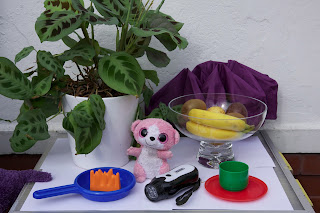The white balance is quite technical but it interesting to play with - the settings basically act as filters that can make subtle or dramatic differences to the final photo.
This is Polly

and Polly helped me set up a little still life so that I could have a look at the different WB settings in daylight. This was a bit of an overcast day.
ISO 100, 17mm lens, 1/250 at f3.5 set manually, fill in flash.
AWB 35mm, ISO 100, 1/160, f8.0
Full sun
Shade
Cloudy
Tungsten light
Fluorescent
Flash
Custom - unset
Kelvin
The camera's estimated setting for this sort of day/light was reasonably accurate.
I tried the same exercise under tungsten light - one that often makes quite a dramatic difference.
AWB - 35mm, ISO 100, 0.4, f8.0
Full sun
Shade
Cloudy
Tungsten
Fluorescent
I didn't think that any of these presets were accurate for the light or looked particularly attractive, unless you really wanted the yellowy atmosphere. I used a white card from one of the photography magazines to take a custom reading and also used some their 18% grey card to help with the exposure.
The result was pretty striking - a really even exposure and accurate whites and colours.
I want to start to use the white balance more accurately when necessary but also more creatively. These shots of Winter Hill were each with different setting and each has a different feel.
Tungsten - 17mm, ISO 100, 1/13, f22
AWB - 20mm, ISO 100, 1/13, f22
Shade - 17mm, ISO 100, 1/10, f22
As the light changes at different times of the day the different WB can be used highten or emphasise colour too. These were taken at dusk using the tungsten setting - something that also helped to create a more interesting atmosphere.
50mm ef, ISO 400, 1/100, F8.0
50mm ef, 1/80, F8.0





























































